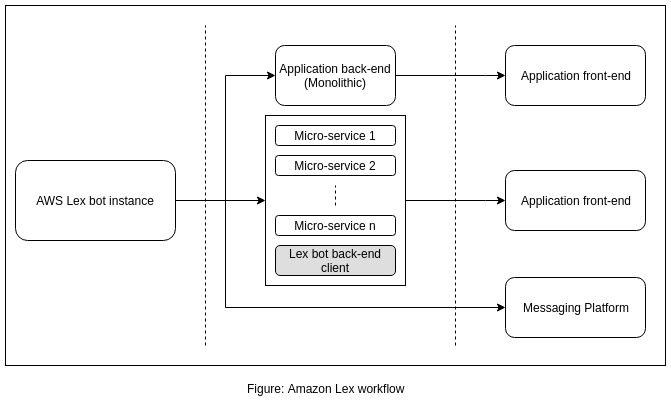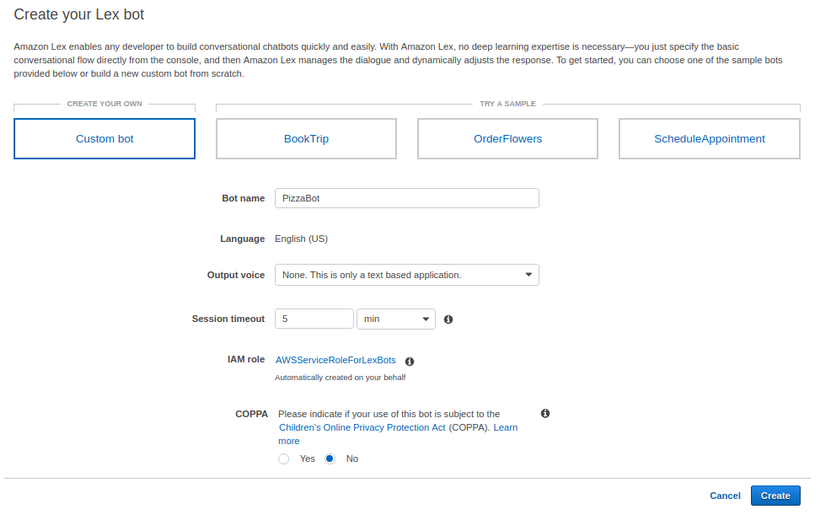Chat-bot development using Amazon Lex
Lex is an easy to use service that makes the task of chat-bot building very fast and hassle free. In a matter of minutes, a fully functional bot can be developed from the scratch. This only leaves a developer with the task of integration, where bot interface is integrated with application ...
Lex is an easy to use service that makes the task of chat-bot building very fast and hassle free. In a matter of minutes, a fully functional bot can be developed from the scratch. This only leaves a developer with the task of integration, where bot interface is integrated with application specific back-end or some messaging platform.

In this article, we'll go through the entire process from building a Lex bot, to a Ruby based web API developement, for wide range of application support. Let's build a pizza ordering bot!
Bot development
Since, the bot is an AWS service, certainly we are going to need an AWS account. Once we have that, the route is simple.
First, go to the AWS console, and from the "Services", select "Amazon Lex" in "Machine Learning" section. Now, choose to create a Lex bot. You will be offered with several options, including some sample. But, we are going to build a bot from the scratch, so we shall choose "Custom bot".
Now, give the bot a name (for our case, it is "PizzaBot"). We are building a text based chat bot, so we are going to set the "Output voice" option to "None". Note that, we are developing a text-only bot. Session timeout decides, for how long the bot should remember a conversation. If you leave an in-progress conversation, and come back within the specified timeout, you will be able to continue from where you left off. Otherwise, a new conversation will start. The last option we need to set in this phase is "COPPA", which should be marked as "No", unless you are developing a bot that contains materal inappropriate for underaged. Now click "Create" to proceed.

Now that we created an identifiable bot, our next step will be to setup the nuts and bolts, to familiarize the bot with our application specific flow. An intent is an action that the user is opted to perform. A bot may have many different intents. For us, to keep the thing simple, let's create a single intent that helps the user to order a pizza. From "Create intent" click "Create new intent" and name it "OrderPizza".
Once we created our intent, we need to provide a sample user response that will trigger the intent. It is called utterance in Lex. Let's add a sample utterance "I would like to order a pizza". ML model in Lex will automatically infer any utterace that goes closely in sync with the sample utterance.
When an utterance is successfully triggered, Lex will look in it's database for any available slot to fill. A slot is a conversational step, where the application prompts the user for a parameter. Every slot has a "slot value". A slot type can be chosen from the available built-in types or a new type can be defined. A slot is passed only if a slot value compatible with the corresponding slot type is provided by the user.
For our "OrderPizza" intent, we have three questions to ask our user. Our application needs to know the pizza type, pizza size and user's address. Since, a slot resembles a question answer cycle, we need three slot types. Click on the "+" sign next to "Slot types" on the left panel. In the slot type creation form, Let's give it a name "PizzaTypes", description "Available pizza types" and slot resolution "Restrict to Slot values and Synonyms". If we choose "Expand Values", Lex will use ML to determine and validate a slot value. Since, we have chosen "Restrict to Slot values and Synonyms", we are restricting user's preference to a predefined enumeration (Of course, if a pizza shop offers only Margarita, we would not like our user to choose "Mexican", right?
